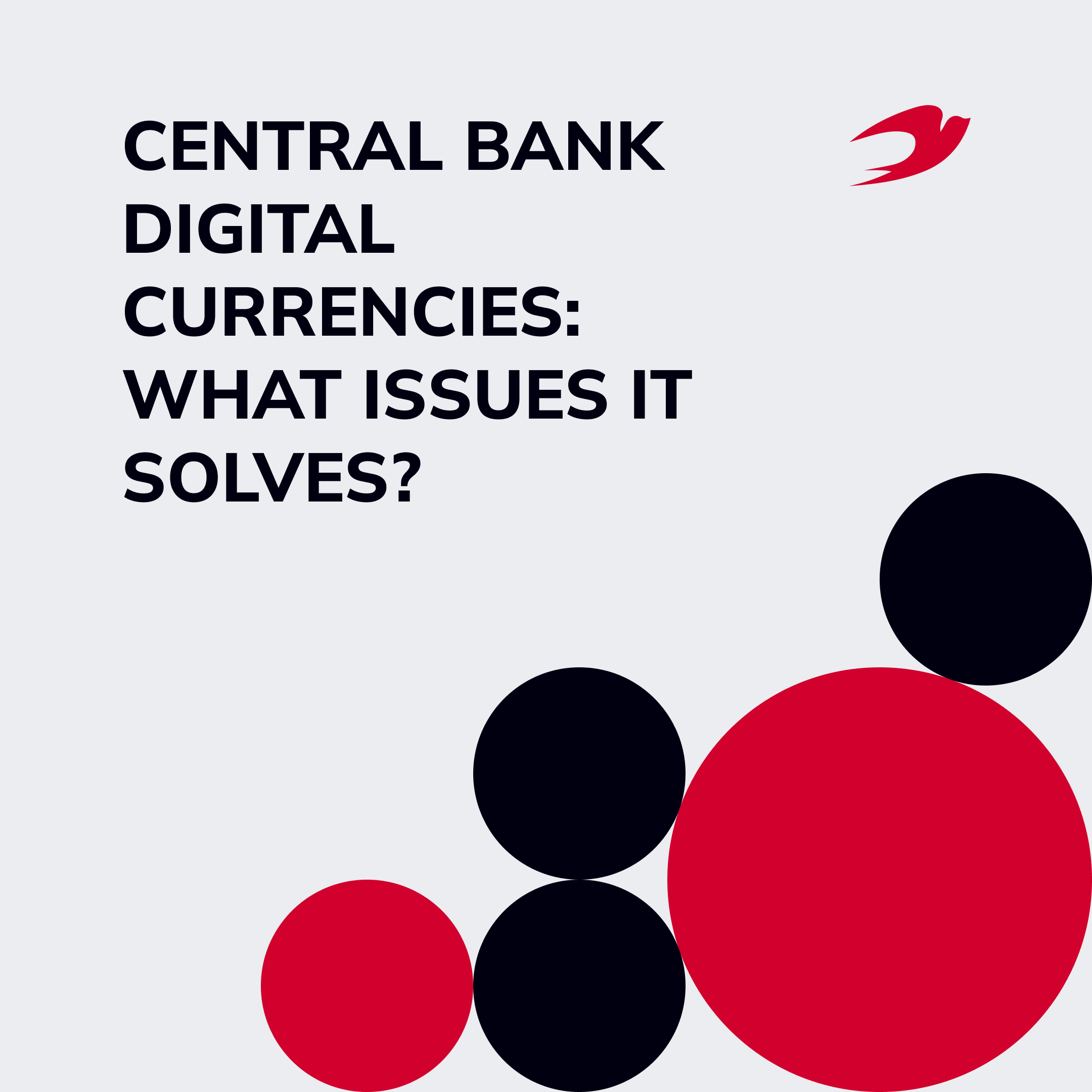Central bank digital currencies, also known as CBDC are a relatively new form of a country’s fiat currency, such as the dollar, euro, yuan or pound, that exists only in digital form. Unlike cryptocurrencies, these are issued by central banks of particular countries and serves as a legal payment option with applications identical to fiat funds.
Currently, the CBDC solution has been explored by almost 120 countries. According to the recent research map by Atlantic Council, over 60 of those either are developing or have already adopted a state-owned digital currency.
A great boost toward CBDC evolution was caused by various factors, with the most notable impact of the global COVID-19 crisis and the rapid development of crypto-based technologies. Today, state-owned digital currencies can make the payment process more efficient, fast, secure and sovereign – this makes CBDC a must-have for the private sector, non-financial customers and enterprises, as well as financial institutions.
In this post, IdeaSoft’s digital fintech experts will explain the potential gains of CBDC solutions, and what makes this solution so important today to get a better idea of its actual value for your projects. As a part of our discussion, you’ll explore the issues the CBDC can solve and some of the most popular questions about this segment of digital currencies.
Table of Contents:
- What Issues Does CBDC Solve?
- Why Is Blockchain Technology So Important for CBDC?
- Essential Requirements for a Custom CBDC Solution
- Summary
What Issues Does CBDC Solve?
With more and more countries starting the CBDC adoption, you might wonder what makes it such a lucrative solution in the financial world. Below we’ve covered the key areas where state-issued digital coins can become the game-changers.

#1 Improved Financial Monitoring
According to Investopedia, one of the most significant issues addressed by CBDC projects is financial monitoring. Not only it enables analyzing the fund flows and payment processing but also aids in timely detecting financial crimes, money laundering, financing of terrorism, fraud activities and more.
Therefore, the CBDC model is aimed to improve welfare through the reduction of financial frictions, boost financial inclusion and enhance the transmission of monetary policy.
#2 Accessibility to Financial Payments
If you’ve already done research about the CBDC concept, you certainly come across the terms “wholesale CBDC” and “retail (general purpose) CBDC”. These categories are similar to cash, though have different fields of use: while wholesale CBDCs are accessible only by financial institutions, retail CBDCs can be used by all agents in the economy (such as individuals, businesses, government agencies, institutions and so on).
Designed for diverse user segments, CBDC is a decent example of financial inclusion, according to which digital cash is available for everyone, anywhere and anytime. At the same time, CBDC features round-the-clock accessibility while featuring high security standards. In some aspects, it is even more secure than physical cash because of its benefit of being digital.
#3 Improved Cross-Border Payments
The cross-border payment industry has faced several notable issues, including high fees, low transaction speed, limited access and insufficient transparency. For instance, a $200 transfer take 3-5 days to process and costs $14 on average.
However, the CBDC can reduce the dependence on the intermediaries, thus improving the time and cost of the transactions – this has become an important subject of interest to dozens of financial institutions across the globe. In particular, this approach is now discussed in terms of Multiple CBDC (launched by China and UAE) and Dunbar (Singapore, Australia, Malaysia and South America) projects.
#4 Anti-Corruption Benefit
Another advantage of the CBDC model is its Anti Money Laundering and Cyber Security features, aimed to reduce corruption in governmental and IMF initiatives.
In this area, it’s worth mentioning the CBDC-based eCurrency Information and Supervision platform, also known as eISS eCurrency. Basically, it enhances the CBDC flow supervision, covering currency transfers, speed, wallets, transactions, and other critical data.
How does that help with corruption? Once the CBDC is implemented, every official has to use a personal CBDC wallet only to keep the money flow transparent. A similar model can be applied to B2B, B2C, and C2C transactions which require full transparency for a state.
Overall, the CBDC implementation allows countries to adjust to numerous dynamic conditions and get their financial market under full control.
#5 Tax Control
Along with the anti-corruption measures, CBDC has a notable impact on the tax system, making it faster, more secure and more reliable. Its basic functionality in this aspect covers real-time taxation, automatic audits and advanced integration with governmental and non-governmental registers.
#6 Investment Attractiveness
Finally, the CBDC approach plays an important role in economical transparency, helping to successfully resolve a vast number of risks. This can have a positive impact on the investment inflow, which is a key factor in the successful development of the country’s economy and its further digitalization.
Why Is Blockchain Technology So Important for CBDC?
For sure, CBDC and cryptocurrencies have a bunch of differences in their structure, which shapes their economical value and sets their areas of use. However, these payment solutions can also benefit each other’s development and growth.
Without any doubt, blockchain has become a backbone technology of a majority of crypto-based solutions in payment, eCommerce, cross-border transfers and other fields. However, despite their decentralized and private nature, this solution still lacks stability and regulatory means. Empowered by blockchain, the CBDC method allows central banks to control the money flow while ensuring the high privacy, independence, safety and robustness of each and every payment for the end users.
The advantages of blockchain also enable CBDCs to increase efficiency and launch more secure payment systems, which are believed to become a decent foundation for government-backed digital currencies in the upcoming years.
Essential Requirements for a Custom CBDC Solution
Building a custom CDBC project requires not only excellent tech expertise but also a deep understanding of the system’s core functionality, business objectives and needs. Based on our expertise in CBDC development, below we’ve uncovered some of the most important aspects to consider for a custom solution within the target niche.
- Improved Accessibility & Inclusivity. To enlarge the scope of the audience, the CBDC solution should feature a universal system design that is accessible to all users, including those with limited access to banking services, low-income households and people with disabilities. Additionally, make sure to incorporate the basic payment instruments and channels to improve its usability.
- Advanced Security. For any tech solution within fintech and banking, system security is a top priority. That is why your custom CBDC solution should feature a robust security framework with the latest protection models covered: encryption, digital signatures, biometric authentication, MFA and more.
- Increased Interoperability. To ensure seamless and efficient transaction flow across multiple platforms and providers, a custom CBDC should be interoperable with other payment systems and infrastructures. In turn, this can result in its higher usability, making the system more competitive and preferable compared to other market alternatives.
- Better Scalability & Efficiency. A scalable CBDC system is more versatile and efficient for both business owners and software users. While the latter can see significant improvements in performance and service fees, business owners will ensure its effectiveness in large transaction processing and stable growth of their CBDC system in general.
- Improved Privacy. CBDC should be designed to protect users’ privacy and personal information while ensuring compliance with anti-money laundering (AML) and counter-terrorism financing (CFT) regulations.
- Powerful Governance. Similarly, your custom CBDC solution must also cover clear governance and accountability mechanisms that ensure high-end transparency, fairness, and accountability across different currency-related actions (such as its issuance, management, etc).
- Transparent Legal Framework. Finally, before launching a custom CBDC project, it’s essential to consider the legal status of the currency, the roles and responsibilities of the issuing central bank, as well as the rights and obligations users take on.
These are only the basic requirements of a standard CBDC solution, which can be modified depending on your project concept, its main objectives and needs. Additionally, you can also add other critical aspects which will help you to better guide the product development and its finalization.
Summary
As you can see, CBDC is an emerging digital payment solution that has the potential to become as popular as physical fiat currencies today. Setting up an official stable digital currency can improve the transaction’s transparency and security at a lower cost, as well as significantly stimulate the state’s economic development.
Due to the increasing interest and comparatively low market competition in CBDC solutions, most experts agree that it’s never been a better time to launch a custom project in this segment. At IdeaSoft, we know how to leverage the potential of crypto technologies to maximize the ROI of your digital product.
With over 200 successful projects delivered, IdeaSoft professionals are aware of today’s each and every tech trend. Contact our team to uncover the most efficient solutions that can help your business to develop and scale today!

